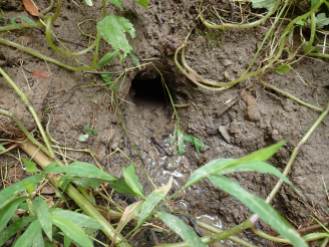Susan and I walked around a community park in Pittsburgh’s north suburbs one evening a few weeks ago, circling the little pond and looking for things that might be living there. Suddenly, we were confronted by a thug, a ruddy fellow with two upraised weapons pointed in our direction. He meant business and he wanted us to turn around and go away. Judging by his flaming cephalothorax, ten agitated appendages, and the glint in his beady eye, I knew he meant business.

“What a fine Procambarus clarkii!” I exclaimed.
Actually I think I said, “That’s a crazy pond lobster!”
It struck me as unusual, even though I’ve never given a lot of attention to crayfish identification. It was big, aggressive and bright red. I photographed several of them before we left, thinking that a crayfish expert should maybe be consulted about this. Susan is something of a lobster expert but that’s only while visiting the eateries of downeast Maine, so that did me no good. If I hadn’t seen these before, after all my time in and around Pennsylvania’s waters, there was a good chance that these just didn’t belong here. By the time I went to bed, I’d decided that these were probably non-native red swamp crayfish.
I’m more aware now than I was a few weeks ago of the situation surrounding invasive crayfishes in the state. Normally, when we fishermen hear of this, it’s a warning in reference to the rusty crayfish, Faxonius rusticus. These invaders showed up in Pennsylvania prior to 1980, appearing first in the lower Susquehanna watershed. They threaten aquatic ecosystems by out-competing native crayfishes and simply consuming much more plant matter than the natives, destroying food and habitat needed by many organisms.
RUSTY CRAYFISH
It’s not really surprising that rusty crayfish eventually arrived here in Pennsylvania from the lower Ohio River but the crayfish I found in the tiny park pond had made a much larger leap. These are natives of the deep south, often the crayfish being prepared for Louisiana cuisine. It seems unlikely they could even survive our Pennsylvania winters yet, there they were. My guess is that they 1) burrow deeply into the clay around the pond, 2) Perhaps make use of the constancy of groundwater sources through the winter, and 3) Diapause (essentially, hibernate). Just best guesses though.
Patrick, the crayfish expert I’d been hoping for, came out from West Liberty University the following week, we took nets in hand and essentially did what both he and I had been doing since early childhood: scooped underwater things in nets and put them in buckets (Patrick might try to claim that it was a bit more sophisticated than that). We made a reasonably good guess as to the extent of the infestation and collected many specimens for lab testing. Through modern DNA technology, the hereditary and spacial pathways by which these invaders had arrived here can possibly be traced.
Our guess was that these guys had been here for quite a while, living happily in a shady suburban hollow. And we saw firsthand what happens when these Cajun invaders establish themselves: The swamp crayfish were prolific almost throughout the tiny watershed and their deep burrows, often under stone retaining walls, made them almost unreachable as far as physical eradication methods are concerned. Before we finished, we found only one sad (and you have to be very attuned to determine the moods of crustacea) native crayfish living among the alien mob.
These invasions are hard to keep track of, difficult to pin down, to know where these things have established themselves and where they’re going next. Anglers are relatively well-educated nowadays about invasive fishes. But these are obvious as compared to the lowly crayfish. Honestly, as of a few weeks ago, I couldn’t have separated a rusty crayfish from a native.
So this is just a call for awareness of this realm. Whatever the long-term implications of various invasives to ecosystems and watersheds, it seems best that we don’t help these invaders along and that we slow them where we can. And it can never hurt that we simply know what we’re looking at when we peer into the waters.



















